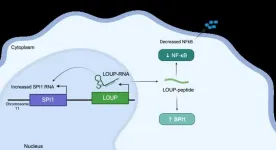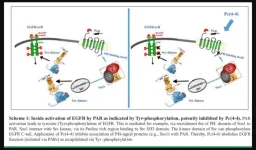(Press-News.org) The SELECT Trial has revealed the potential of semaglutide, a glucagon-like peptide-1 (GLP-1) receptor agonist, in combating kidney function decline among individuals with overweight or obesity and established cardiovascular disease but without diabetes.1
Unveiling the results today at the 61st ERA Congress, researchers presented the impressive secondary analysis from the SELECT (Semaglutide Effects on Heart Disease and Stroke in Patients with Overweight or Obesity) trial, a randomised trial comprising a participant pool of 17,604 individuals.
Experts believe the study’s results offer hope for those affected by obesity, a condition known to exacerbate the risk of kidney function decline and macroalbuminuria (abnormal amounts of the albumin protein in urine).2
With an average follow-up of approximately 3.5 years, among patients who were administered a once-weekly subcutaneous injection of semaglutide 2.4 mg (n=8,803) adverse kidney-related events were experienced by 22% fewer persons (1.8%) compared to those receiving placebo (n=8,801) (2.2%) (p<0.05). These events included death from kidney causes, initiation of chronic kidney replacement therapy, significant (≥ 50%) decline in kidney function, or onset of persistent macroalbuminuria. Semaglutide's ability to prevent the onset of macroalbuminuria was highlighted as a pivotal factor in reducing the likelihood of kidney-related complications.
The study also assessed the impact of semaglutide on estimated glomerular filtration rate (eGFR), a measure of kidney function in removing waste and excess water from the blood through urine. The findings indicated a significantly lesser decline in eGFR among semaglutide recipients compared to the placebo group, with the effect being more pronounced in participants with baseline eGFR below 60 mL/min/1.73 m² (p<0.001). These results indicate the potential for semaglutide to particularly protect kidney function in individuals with a pre-existing kidney impairment.
The reduction in urinary albumin-to-creatinine ratio (UACR) further substantiated semaglutide's beneficial effect on kidney health, with a significant decrease observed in semaglutide-treated individuals compared to placebo (p<0.001). UACR analysis measures the ratio of albumin (a protein) to creatinine (a waste product) in urine, aiding the detection of albuminuria, which can signal kidney damage or dysfunction. With semaglutide, there was a net 8.1% decrease in UACR in those with normal albumin levels at baseline, a 27.2% decrease in those with microalbuminuria (slightly raised albumin) at baseline, and a 31.4% decrease in those with macroalbuminuria at baseline relative to placebo.
Importantly, the study found no increased risk of acute kidney injury associated with semaglutide treatment, irrespective of baseline kidney function.
Over one billion people worldwide are affected by obesity.3 Rates of obesity are rising significantly, having doubled among adult women (8.8% to 18.5%) and nearly tripled in adult men (4.8% to 14.0%) between 1990 and 2022. The total number of children affected by obesity in 2022 was nearly 160 million, compared to 31 million in 1990.4
Professor Helen M. Colhoun, lead study author, commented, “By addressing key markers of kidney health, semaglutide 2.4 mg weekly may contribute to a significant reduction in the risk of kidney-related complications, including chronic kidney disease and end-stage renal disease. This could lead to improved management of comorbidities and, ultimately, enhance the quality of life for individuals with obesity.”
“The observed benefits in eGFR and UACR are particularly encouraging, suggesting potential for the enhanced management of kidney complications in the patient population with overweight and obesity without diabetes. The findings also underscore the importance of continued research into the possible renal benefits of semaglutide and highlight its role as a promising therapeutic option in the multifaceted management of cardiovascular and renal health in this high-risk population."
ENDS
Notes to editors:
A reference to the ERA Congress must be included in all coverage and/or articles associated with this study.
For more information or to arrange an expert interview, please contact press@era-online.org
About the study author:
Professor Helen M. Colhoun holds the AXA Research Fund endowed Chair in Medical Informatics and Epidemiology at the University of Edinburgh. Her research interests include clinical trials to reduce cardiovascular and other complications in people with and without diabetes and large scale epidemiological studies of the pathogenesis and opportunities for preventing such complications using molecular epidemiology approaches.
About the European Renal Association (ERA):
With more than 18,000 active members, the ERA is one of the biggest nephrology associations worldwide leading European nephrology, and one of the most important European Medical Associations. It organises annual congresses and other educational and scientific activities. The ERA also collects data and performs epidemiological studies through its Registry. The Society supports fellowships and educational/research projects through its committees and working groups. Its publications are NDT, CKJ (Open Access journal), and the online educational portal NEP.
The 61st ERA Congress takes place between 23-26 May 2024, both virtually and live in Stockholm, Sweden.
Website: www.era-online.org
References:
Effect of semaglutide on kidney outcomes in people with overweight or obesity and established cardiovascular disease in the SELECT trial, Colhoun H. M. (2024). Presented at the ERA Congress 2024.
Kovesdy, C. P., Furth, S. L., Zoccali, C., & World Kidney Day Steering Committee (2017). Obesity and kidney disease: hidden consequences of the epidemic. Journal of nephrology, 30(1), 1–10. https://doi.org/10.1007/s40620-017-0377-y
World Health Organization (2024). One in eight people are now living with obesity. https://www.who.int/news/item/01-03-2024-one-in-eight-people-are-now-living-with-obesity
Imperial College London (2024). More than one billion people now living with obesity, global analysis suggests. https://www.imperial.ac.uk/news/251798/more-than-billion-people-living-with/#:~:text=In%20adults%2C%20obesity%20rates%20more,to%206.2%25%20in%20men). END
A groundbreaking study, presented today at the 61st ERA Congress, has uncovered a significant breakthrough in the diagnosis and monitoring of kidney diseases associated with nephrotic syndrome.1
Using a hybrid technique, researchers identified anti-nephrin autoantibodies as a reliable biomarker for tracking disease progression, opening new avenues for personalised treatment approaches.
Nephrotic syndrome, characterised by elevated protein levels in the urine, is linked to kidney diseases such as minimal change disease (MCD), primary focal segmental glomerulosclerosis (FSGS), and membranous nephropathy (MN). The primary cause behind nephrotic syndrome is damage to podocytes, the ...
Protest movements that reject political parties have an unintended consequence, according to new research from the University of Notre Dame: They empower savvy politicians who channel them to shake up the status quo.
The findings provide a framework for understanding recent global political realignments and offer lessons for activists who want to make a meaningful impact. They are particularly relevant in an era when mass protests have become an increasingly common tool to voice dissent with powerful institutions and draw attention to overlooked issues ranging from climate and conflict ...
UC Santa Cruz researchers have discovered a peptide in human RNA that regulates inflammation and may provide a new path for treating diseases such as arthritis and lupus. The team used a screening process based on the powerful gene-editing tool CRISPR to shed light on one of the biggest mysteries about our RNA–the molecule responsible for carrying out genetic information contained in our DNA.
This peptide originates from within a long non-coding RNA (lncRNA) called LOUP. According to the researchers, ...
Imagine if your dead laptop or phone could charge in a minute or if an electric car could be fully powered in 10 minutes.
While not possible yet, new research by a team of CU Boulder scientists could potentially lead to such advances.
Published today in the Proceedings of the National Academy of Sciences, researchers in Ankur Gupta’s lab discovered how tiny charged particles, called ions, move within a complex network of minuscule pores. The breakthrough could lead to the development of more efficient energy storage devices, such as supercapacitors, said Gupta, an assistant professor of chemical and biological engineering.
“Given the critical role ...
ORLANDO, May 24, 2024 – For the first time, carbon dioxide and carbon monoxide ices have been observed in the far reaches of our solar system on trans-Neptunian objects (TNOs).
A research team, led by planetary scientists Mário Nascimento De Prá and Noemí Pinilla-Alonso from the University of Central Florida’s Florida Space Institute (FSI), made the findings by using the infrared spectral capabilities of the James Webb Space Telescope (JWST) to analyze the chemical composition of 59 trans-Neptunian objects and Centaurs.
The pioneering study, published ...
NEWPORT NEWS, VA – Nuclear physicists have long been working to reveal how the proton gets its spin. Now, a new method that combines experimental data with state-of-the-art calculations has revealed a more detailed picture of spin contributions from the very glue that holds protons together. It also paves the way toward imaging the proton’s 3D structure.
The work was led by Joseph Karpie, a postdoctoral associate in the Center for Theoretical and Computational Physics (Theory Center) at the U.S. Department of Energy's Thomas Jefferson National Accelerator Facility.
He said that this decades-old mystery began with measurements of the sources of the proton’s spin in ...
Up to 80% of breast cancer deaths occur in patients with tumors that express estrogen receptor-alpha. Although these estrogen receptor-positive (ER+) breast cancers often initially respond to standard treatment that combines endocrine therapies with CDK4/6 inhibitors, drug resistance often develops leading to lethal metastatic disease that spreads from the breast and does not respond to available treatments.
Looking to identify new vulnerabilities in this type of cancer that could lead to improved therapies, ...
“We have identified binding motifs within the C-tails of PAR1,2&4, indispensable for cancer growth and development.”
BUFFALO, NY- May 24, 2024 – A new editorial paper was published in Oncoscience (Volume 11) on April 25, 2024, entitled, “PH-binding motifs as a platform for drug design: Lessons from protease-activated receptors; PARs.”
While targeted cancer therapy is greatly dependent on specific oncogenic pathways or conferred by genetic alterations, it remains yet challenging and somewhat disappointing. The high level of failure relies ...
Undergoing surgery is seldom a pleasant experience, and it can sometimes be highly invasive. Surgical procedures have evolved steadily over the centuries, growing with the knowledge of anatomy and biology.
Innovative methods have also been bolstered with new tools, and a growth in the use of robotics since the 1980s has moved health care forward significantly. Assistant Professor Zhenhua Tian has pressed forward another step in the march of progress using robotics and noninvasive acoustics, and his team’s work has been published in Science Advances.
Robot-assisted surgery
Surgery using robots has been invasive since its invention because ...
LOGAN, UTAH, USA – A long-standing debate among evolutionary scientists goes something like this: Does evolution happen in a predictable pattern or does it depend on chance events and contingency? That is, if you could turn back the clock, as celebrated scientist Stephen Jay Gould (1941-2002) described in his famous metaphor, “Replaying the Tape of Life,” would life on Earth evolve, once again, as something similar to what we know now, or would it look very, very different?
“If you frame it as an either/or question, it’s too simplistic,” says Utah State University evolutionary biologist Zachariah Gompert. “The answer isn’t ‘completely ...





